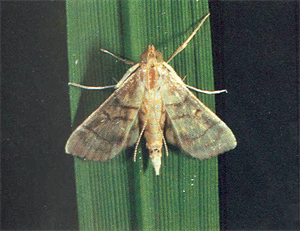Rice leaf roller
Pacific Pests, Pathogens and Weeds - Online edition
Pacific Pests, Pathogens & Weeds
Rice leaf roller (415)
Marasmia exigua. It is also known as Cnaphalocrocis exigua, Samea exigua, and Susumia exigua. A moth of the Crambidae.
Asia, Oceania. It is recorded in Australia, American Samoa, Fiji, French Polynesia, Guam, New Caledonia, Northern Mariana Islands, Papua New Guinea, Samoa, and Solomon Islands.
Rice, maize, and wild grasses.
The larvae do the damage to seedbed rice or young rice in the field; they fold the leaves or fix two or more together. They feed inside the tunnel created, scraping the leaf surface, making long white scars. From a distance the leaves appear grey. The moth is more common in upland rice than rainfed wetland or irrigated crops.
Eggs are occasionally laid singly or in groups of about 10; they are ovoid, flattish where joined to the leaf, and overlap each other in rows. In Fiji, eggs are laid on the tallest, greenest plants in the field. Early larvae feed together; later ones are solitary, yellowish-green with pale-brown heads, up to 11 mm (Photo 1). This is the stage when they begin to roll leaves. There are several moults over about 4-6 weeks. There is no pupal cocoon, but silken threads and frass hold the pale-yellow pupa to the leaf. Adults are about 7 mm long, with a wingspan of 13 mm. Wings are pale-yellow with grey-brown borders and three or four brown bands (Photo 2).
The rice leaf roller is considered a minor pest of rice in Asia. However, in Fiji its status changed in the 1970s from being an insignificant pest into one of the most destructive in the country, causing "complete destruction of the [summer] crop if appropriate control measures are not taken"1. This change followed the introduction of new high-yielding varieties, and the application of nitrogen.
Look for folded or rolled leaves, larvae and frass. Look for the bands across the wings of the adult. However, there are several rice leaf rollers and leaf folders [e.g., Cnaphalocricus medinalis (see Fact Sheet no. 414) and Marasmia patnalis] that are similar and expert examination is needed to separate the species.
BIOSECURITY
Countries not yet infested by the rice leaf roller should consider all likely pathways for entry, and apply quarantine measures accordingly. It is a major pest of rice in Fiji, in particular. Many countries throughout Africa, the Americas and also Oceania are at risk. Pathways of introduction are likely to be via produce contaminated by pieces of stem of the hosts infested with larvae or pupae.
NATURAL ENEMIES
Those parasitoids and parasites active against Cnaphalocricis medinalis (see Fact Sheet no. 414) are likely to attack the rice leaf roller, too. In Fiji, Trichogramma species parasitise the eggs of the rice leaf roller, and Trathala flavo-orbitalis destroy more than 40% of the larvae. However, although biological control suppressed the moth population, high yielding varieties were still damaged..
CULTURAL CONTROL
Before planting:
- Remove weeds on the bunds as many are hosts of the larvae.
- Fallow land after rice, or if that is not possible rotate with a different crop.
- Increase plant spacing; there is a suggestion that it may lower populations of the moth.
During growth:
- Do not over apply fertilizer: apply recommended doses at the times suggested. Get advice from government extension officers if this is not known. Using low rates of nitrogen fertilizer may reduce populations of the moth.
- Weed, remove wild grasses that are alternative hosts.
After harvest:
- Avoid ratooning the crop as the larvae can carry over to the new tillers as they emerge.
- Flood the field after harvest or, if not possible, plough the land, turning the stubble into the soil.
RESTISTANT VARIETIES
Varieties differ in resistance to the rice leaf roller compared to new high-yielding varieties. In previous research, in Fiji, variety New Guinea, an ‘old’ variety was more resistant than Boldgrain, a ‘new’ one. The variety New Guinea could be used in summer months when moth populations are high. Contributing factors affecting populations are nitrogen levels, plant density, continuous planting and whether the rice is cultivated wetland or dryland.
CHEMICAL CONTROL
In most countries Marasmia exigua is considered a minor pest and insecticides are not recommended. In Fiji, where severe damage has been recorded, insecticides may be required. If so, do the following:
- Use biorational insecticides, such as neem seed oil (oil from the fruits and seeds of the neem tree, Azadirachta indica), abamectin (a fermentation product from a soil bacterium), or spinosad (isolated from a soil actinomycete).
- In Fiji, the carbamate, Carbaryl, has been recommended. Other synthetic products, e.g., pyrethroids, such as cypermethrin are likely to be effective, but will destroy parasitoids and predators.
- Insecticides may destroy the parasitoids and predators of OTHER insects, e.g., the brown plant hopper, and result in a rapid increase (‘resurgence’) of populations.
____________________
When using a pesticide, always wear protective clothing and follow the instructions on the product label, such as dosage, timing of application, and pre-harvest interval. Recommendations will vary with the crop and system of cultivation. Expert advice on the most appropriate pesticide to use should always be sought from local agricultural authorities.
AUTHOR Grahame Jackson
1Information from Singh SR (1997) Biology of the rice leafroller Cnaphalocrocis (Marasmia) exigua (Butler) (Lepidoptera): Pyralidae: Pauristinae) in Fiji. PhD Thesis. Faculty of Science, Technology and Agriculture, University of Western Sydney, Australia. (https://researchdirect.westernsydney.edu.au/islandora/object/uws:443); and Phathak MD (1975) Insect pests of rice. The international Rice Research Institute. 3rd printing; and from CABI (2018) Marasmia exigua (rice leaf roller). Invasive Species Conpendium. (https://www.cabi.org/isc/datasheet/32496). Photos 1&2 Rice-feeding insects of Tropical Asia. IRRI Photos. Flickr. (https://www.flickr.com/photos/ricephotos/6676485397).
Produced with support from the Australian Centre for International Agricultural Research under project HORT/2016/185: Responding to emerging pest and disease threats to horticulture in the Pacific islands, implemented by the University of Queensland and the Secretariat of the Pacific Community.





